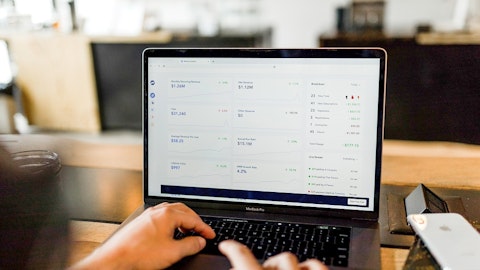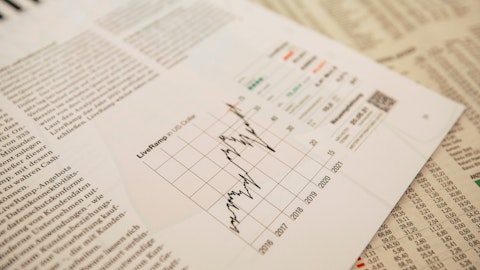Michel Khalaf: Yes. Hi, Ryan. It’s Michel. I mean I would say the short answer is no, no change in philosophy in our approach. And I might sound like a broken record here, but that’s probably a good thing. So from our standpoint, the approach is that beyond supporting organic growth and in the absence of strategic accretive M&A, excess capital belongs to shareholders. And we’ve defined that as cash and equivalents at our holding companies above our liquidity buffer of $3 billion to $4 billion. And we do expect to migrate back to those levels over time. But just given the environment, I think having the financial flexibility that being above that range offer is not a bad thing. We’ve bought back $3.3 billion in 2022, an additional $250 million in January.
And we have $900 million left on our current authorization. And as we’ve done in the past, we’re going to continue to manage the authorization deliberately and in a consistent manner, I would say. So from that perspective, no change in terms of approach or philosophy.
Ryan Krueger: Thank you.
Operator: And our next question is from Jimmy Bhullar with JPMorgan. Please go ahead. Mr. Bhullar, do you have your phone muted by chance. We will move on to the next person, one moment here. We’ll move on to Alex Scott . Please go ahead.
Alex Scott: Hey, good morning. First one I had is just on LDTI, could you provide an update on how book value is impacted as we sort of move over to that accounting as of year-end? And the reason I asked is just I want to better understand the ROE guidance that you’ve provided as part of your outlook. And then maybe if you can comment at all on how sensitive that will be to interest rates as we think through declining rates in the first quarter?
John McCallion: Good morning, Alex. It’s John. So we gave a range before, and we’ll be providing a point estimate as we file our 10-K in the middle of that range was, call it, all in about a 22.5 change in total equity and about a $5 billion, so $22.5 billion and a $5 billion change in book value ex-AOCI, excluding FCTA. That was at 1/1/21. Since that time, obviously, a lot has changed in terms of economic and interest rate environments. And so I think if you were to compare to year-end this year of ’22, the delta should be much different or smaller, at least, certainly, on book value ex-AOCI would be about 2 – a little less than a $2 billion, call it, impact on book value ex-AOCI. And then if you include AOCI, it actually flips a little bit to $2 billion positive from the overall $22.5 billion negative to GAAP equity. So hopefully, that helps.
Alex Scott: Yes, that’s very helpful. Thank you. And then the second one I had is on LatAm and the outlook. You guys have had really strong growth there. How influenced has it all been by the macro environment and the employment in Mexico, which candidly am a little less doubt in on myself? And I just wanted to understand like, to what degree that’s been fueling things and what that could look like if it more levels off or is not as robust as it’s been? And then maybe also if the Chile pension reform does go into effect in 2024? Would that change your view on the growth rates on sort of the outer years of the guidance you gave?
Eric Clurfain: Okay. Hi, Alex. This is Eric. Let me take the first question regarding the LatAm outlook. So as you mentioned, and you’ve seen 2022 results and our near-term guidance, we’re excited about our prospects in Latin America for a number of reasons. And let me put things in perspective. So we, as you know, we have a strong franchise across the region. We have a significant footprint in three of the largest insurance markets across LatAm. We are market leaders with a very strong brand in Mexico and Chile, and we have a fast-growing business in Brazil. So in addition, the market in the region has significant potential for three reasons in addition to the one that you mentioned. But the three core reasons that are really pushing things forward are, one, the insurance penetration rates remain very low.
We are also seeing heightened protection awareness resulting in increased demand for our products. We’re also observing an increased expectations from customers for more of a digital and seamless experience, and this is leading to a flight to quality that I mentioned during last year. And these evolving customer needs have been met by our franchise because we have invested significantly in our digital transformation over the past few years, and that digital transformation in both sales and service levels is now paying off clearly. And in parallel, we’ve been expanding and diversifying our distribution and product reach by growing bancassurance, direct marketing channels, while continuing to strengthen and grow our retail and group business across the region.
The good example of that diversification strategy in Mexico where we had a record top and bottom line here in 2022. So we’ve been also expanding successfully in the private business in both retail and group while continuing that strong franchise that you know very well in worksite government. So all in all, I think there are market factors that are helping, but the strength of our franchise and our strategy is certainly positioning us well for the future and moving forward. So I hope this helps on the LatAm question. And I’ll pass it to Michel regarding the Chile view.
Michel Khalaf: Yes. I mean the thing I would say about Chile is that I think all in all, we feel better about the environment. The pension reform is going to play out over, say, a number of months. And we’ll have to see how things turn out. But all in all, I think compared to maybe six months ago, I would say the environment is better, more favorable.
Alex Scott: Got it. Thank you.
Operator: And we will go back to the line of Jimmy Bhullar with JPMorgan. Please go ahead. Mr. Bhullar, we are still unable to hear you. We will move on to Suneet Kamath . You may go ahead.
Suneet Kamath: Hi. Can you hear me? A – Michel Khalaf Yes. Suneet, go ahead.
Suneet Kamath: Okay, great. Perfect. So my first question, just on VII, I think I know the answer, but I figured I’d ask anyway. It looks like you’ve kept your return assumption consistent despite the economic uncertainty that you’ve talked about on this call. Is that just for the simplicity of being consistent with the past? Or is that at all informed by what you’re hearing from your private equity partners?
Steven Goulart: Hi, Suneet. It’s Steve. Thanks for the question. And this really reflects the fact that we don’t want to try and predict near-term market quarterly or annual returns. This really reflects our long-term experience for the asset class and then therefore our expectation going forward. So that’s why I think if you go back, it’s been 12%, 3% a quarter as long as I can recall. And again, it reflects the fact that we know that – a couple of things. One is that there is volatility in the returns. But basically, our PE portfolio has generally moved directionally in line with the broad markets. If you can look at the fourth quarter, what happened, we had basically strong kind of broad market returns. NASDAQ was down a little bit.
I’m sure that will reflect its way through the portfolio as well. The key, though, is despite any volatility we see in the returns on the portfolio, we’re also getting very solid cash distributions. And last year, we had over – about $2.5 billion of cash distribution. As you look at the last 5 years, they’ve totaled $9 billion. So it really is a very reliable portfolio in that respect as well. And I think a lot of it just reflects the diversification in the portfolio. I mean we’ve said a number of times, we’re very diversified by strategy, by manager, by vintage. Yes, LBOs and BC are the biggest part of the portfolios, but we also have significant investments in specialized strategies like special situations, energy, power and the like. So all in all, our expectations really reflect the long-term experience we’ve seen in the portfolio that represents the strong diversification we have.
Suneet Kamath: Got it. That’s helpful. And then, I guess, for John, it looks like you were able to use this Japanese reinsurance transaction to help solve for some of the uneconomic pieces of the SMR. Should we be thinking about this as another tool that you have going forward in terms of capital optimization? Or was this really just to solve that issue?
John McCallion: Good morning, Suneet. Yes, I think you’ve done a nice job summarizing it. It’s a tool in the toolbox. We – it’s not our only. We did use it to solve that situation. It was – in the fourth quarter, we executed an internal reinsurance transaction, which improved the ratio by approximately 250 points. And so – and also remember, there is two other things. One, rising rates are good for this business. So that’s important to remember from an economic perspective. Second is the solvency regime is meant to be replaced in a few years time and move to a more economic solvency framework that will better reflect the economics. So this is really to deal with, I’ll say, a temporary situation. And ultimately, I think these tools allow us to have no concerns over capital generation or dividend capacity.





